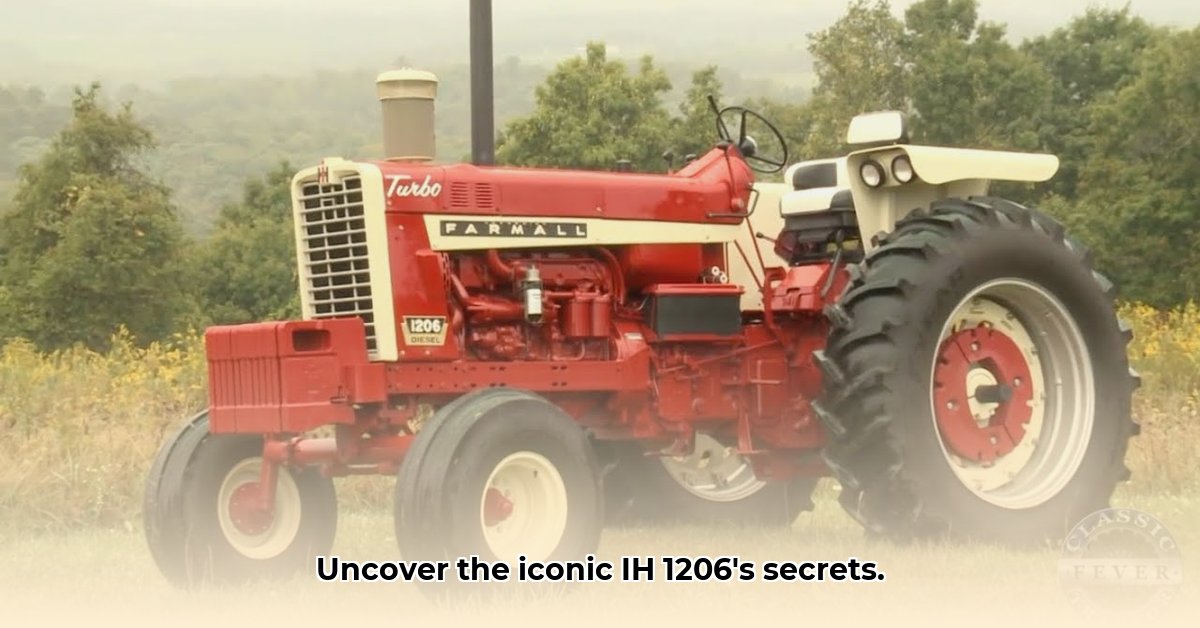
The International Harvester 1206 and its sibling, the Farmall 1206, were iconic tractors that defined agricultural machinery in the 1960s. This article provides a detailed comparative analysis of these workhorses, examining their design, performance, and lasting impact on farming practices. We'll explore their technical specifications, delve into their historical context, and assess their continued relevance for collectors and enthusiasts. For comparison, see this article on a 1960s John Deere Tractor.
Design and Specifications: A Side-by-Side Comparison
Both the IH 1206 and Farmall 1206 offered substantial power for their era. Drawbar horsepower (the power available at the tractor's hitch) hovered around 100 hp, while PTO (power take-off) horsepower, used for powering implements, reached approximately 112 hp. However, precise figures varied depending on testing methods and variations in production. This variance is common among older machinery due to less standardized testing procedures compared to modern standards. Why is consistent horsepower data so important for evaluating the performance of these tractors? Because accurate power output is essential to match the tractor's capabilities to appropriate tasks, ensuring optimal productivity and efficiency.
The transmission systems differed significantly. The IH 1206 employed an eight-speed, unsynchronized transmission, demanding skill and precision during gear changes, particularly when under load. The Farmall 1206, conversely, boasted a 16-speed partial power shift transmission, providing a smoother and more versatile operating experience. This difference reflects the varying intended uses of the tractors.
Another key distinction lies in their wheelbases. The Farmall 1206, designed for row crop farming, featured a longer wheelbase (101 inches) compared to the IH 1206's 91 inches. This longer wheelbase provided enhanced stability and maneuverability in narrow rows critical for minimizing crop damage and soil compaction.
Fuel tank capacity also varied. Both tractors had relatively small tanks by modern standards; roughly 35 gallons for the IH 1206 and 42 gallons for the Farmall 1206. This resulted in more frequent refueling stops. While precise fuel consumption data is scarce, the smaller tank size suggests lower fuel efficiency compared to newer models.
Here's a summary of the key specifications:
| Feature | IH 1206 | Farmall 1206 |
|---|---|---|
| Engine HP (Drawbar) | ~100 HP | ~100 HP |
| Engine HP (PTO) | ~112 HP | ~112 HP |
| Transmission | 8-speed Unsynchronized | 16-speed Partial Power Shift |
| Wheelbase | 91 inches | 101 inches |
| Fuel Tank Capacity | ~35 gallons | ~42 gallons |
Performance and Capabilities: On the Field
Both the IH 1206 and Farmall 1206 proved capable of handling a wide range of agricultural tasks. Their power and relatively robust build allowed them to perform plowing, cultivating, planting, and harvesting tasks. The Farmall 1206's longer wheelbase was especially advantageous in row crop agriculture, where stability and maneuverability are paramount. How did these tractors affect the yields farmers achieved? Anecdotal evidence suggests a significant increase in efficiency, though quantifiable data remains difficult to obtain for these older machines.
Technological Context: Agricultural Advancements of the Era
The 1206 series emerged during a period of significant advancement in agricultural technology. While not incorporating the advanced electronics and hydraulic systems of later models, they represented improvements over earlier tractors in terms of horsepower, transmission options, and overall efficiency. What were the limitations of the IH 1206 and Farmall 1206 compared to modern tractors? They lacked the sophisticated features and fuel efficiency of contemporary equipment, reflecting the evolving technology of the time. Their design underscores the engineering trade-offs of that era.
Market Impact and Legacy: A Lasting Impression
The success of the 1206 series is evident in its production numbers. An estimated 1,289 IH 1206 and 8,400 Farmall 1206 tractors were manufactured, signifying considerable market penetration. Their reliability, adaptability, and power suited the needs of numerous farmers. Today, these tractors hold a special place in the hearts of collectors and agricultural history enthusiasts, representing a pivotal era in farming mechanization. How has the enduring popularity of the 1206 series affected its current market value? These well-maintained tractors command significant prices in the collector market, reflecting their appeal among enthusiasts and their historical significance.
Conclusion: A Powerful Legacy
The IH 1206 and Farmall 1206 tractors, despite their age, remain significant symbols of agricultural progress in the 1960s. Their design, performance, and market success showcase the engineering and manufacturing capabilities of the era, solidifying their place in agricultural history. Their legacy continues to resonate with both collectors and those interested in the evolution of farming technology.